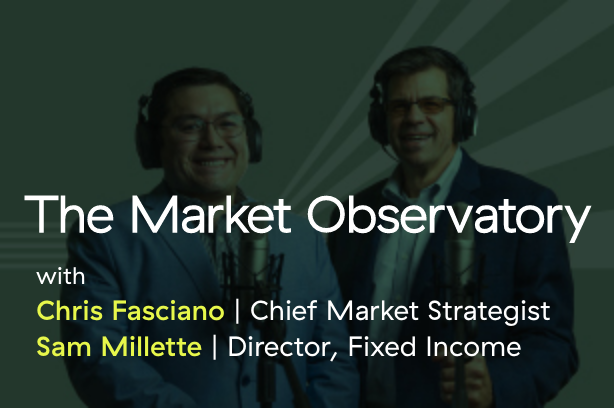Do I think the Fed has been clear it's not going to react to headlines? I discussed this and more today on Yahoo Finance’s YFi AM.

Do I think the Fed has been clear it's not going to react to headlines? I discussed this and more today on Yahoo Finance’s YFi AM.
August 22, 2019
This afternoon I appeared on CNBC’s The Exchange to discuss the Fed and rate cuts. Listen in to learn more.
Earlier today, I appeared on Yahoo Finance Live: The Final Round to discuss the economy, including consumer spending. Listen in to learn more.
August 21, 2019
Starting this week, my colleague Sam Millette, senior investment research analyst on Commonwealth’s Investment Management and Research team, will be helping me with the Monthly Market Risk Update posts. Thanks for the assist, Sam!
It’s time for our monthly look at market risk factors. Just as with the economy, there are several key factors that matter for the market in determining both the risk level and the immediacy of the risk. Although stocks remain close to all-time highs, the recent volatility is a reminder that, given valuations and recent market behavior, it is useful to keep an eye on these factors.
August 20, 2019
Starting this week, my colleague Sam Millette, senior investment research analyst on Commonwealth’s Investment Management and Research team, will be helping me with the Economic Risk Factor Update posts. Thanks for the assist, Sam!
The economic data released last month was mixed, with improvements in consumer confidence offset by declining business sentiment. Job creation continued to be solid, but there are signs of a slowdown. The yield curve remains inverted despite the rate cut made at the Fed’s July meeting. Although we are not yet at immediate risk levels, there are certain areas of the economy that should be watched closely going forward.
August 15, 2019
Yesterday, we saw the largest stock market drop of the year. The Dow Jones Industrial Average was down more than 800 points (over 3 percent), an even bigger decline than we saw earlier this month. Plus, we are on track for the worst week of the year. It is a tough time for markets, and investors are worried. But should they be?
August 6, 2019
The past week has been a tough one for stock investors. The S&P peaked on July 26, and it has dropped every day since then for a total decline of almost 6 percent (as of the close of August 3). This is a large and fast drop that has understandably rattled investors, who wonder why the sudden pullback—and whether it will continue.
In July, U.S. markets were up overall, between 1 percent and 2 percent, and bonds also had gains as interest rates declined. Although international markets were down slightly, by about 1 percent or so, they remained above their long-term trend lines. From a financial perspective, July wasn’t a great month, but it was a pretty good one for investors.
Yesterday, I appeared on CNBC's Nightly Business Report (my segment starts at 6:08) to discuss the market and my expectations for the month of August. Listen in to learn more.
August 1, 2019
July was a mixed month, with some good news and some bad. U.S. markets rose and fixed income went up, but emerging markets pulled back. In the U.S., second-quarter growth beat expectations, buoyed by the consumer. People were willing and able to spend, a trend that is likely to continue. Earnings also went up, another positive surprise. Still, risks remain, including the threat of Brexit under Prime Minister Boris Johnson.

Episode 13
November 19, 2025
Episode 12
October 14, 2025
Episode 11
September 10, 2025
Episode 10
August 13, 2025
Episode 9
July 23, 2025
The information on this website is intended for informational/educational purposes only and should not be construed as investment advice, a solicitation, or a recommendation to buy or sell any security or investment product. Please contact your financial professional for more information specific to your situation.
Certain sections of this commentary contain forward-looking statements that are based on our reasonable expectations, estimates, projections, and assumptions. Forward-looking statements are not guarantees of future performance and involve certain risks and uncertainties, which are difficult to predict. Past performance is not indicative of future results. Diversification does not assure a profit or protect against loss in declining markets.
The S&P 500 Index is a broad-based measurement of changes in stock market conditions based on the average performance of 500 widely held common stocks. All indices are unmanaged and investors cannot invest directly in an index.
The MSCI EAFE (Europe, Australia, Far East) Index is a free float‐adjusted market capitalization index that is designed to measure the equity market performance of developed markets, excluding the U.S. and Canada. The MSCI EAFE Index consists of 21 developed market country indices.
One basis point (bp) is equal to 1/100th of 1 percent, or 0.01 percent.
The VIX (CBOE Volatility Index) measures the market’s expectation of 30-day volatility across a wide range of S&P 500 options.
The forward price-to-earnings (P/E) ratio divides the current share price of the index by its estimated future earnings.
Third-party links are provided to you as a courtesy. We make no representation as to the completeness or accuracy of information provided on these websites. Information on such sites, including third-party links contained within, should not be construed as an endorsement or adoption by Commonwealth of any kind. You should consult with a financial advisor regarding your specific situation.
Member FINRA, SIPC
Please review our Terms of Use.
Commonwealth Financial Network®